Key takeaways:
- Understanding and managing factors like light, temperature, humidity, and airflow is crucial for healthy cannabis growth.
- Consistency in environmental control can lead to significant improvements in plant health and yield.
- Investing in quality equipment, such as proper lights and humidity monitors, significantly enhances cultivation success.
- Regular maintenance routines, including pest inspections and cleaning, are essential for preventing issues and ensuring optimal growing conditions.
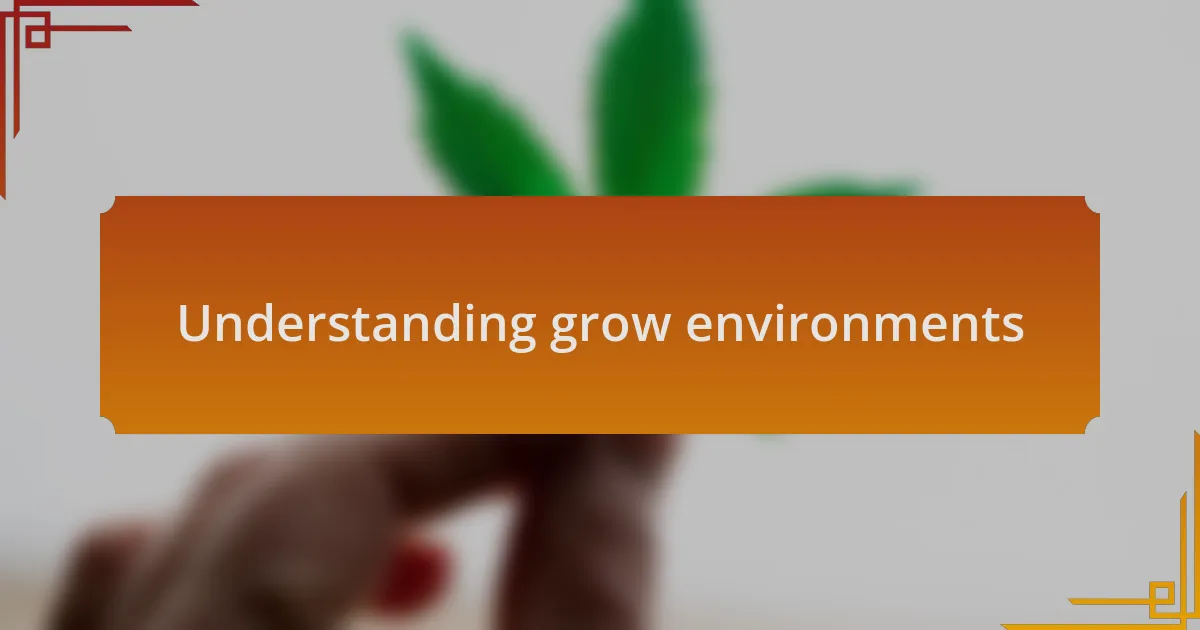
Understanding grow environments
Understanding grow environments is crucial if you want to cultivate healthy cannabis plants. Each type of environment—be it indoor or outdoor—presents its own challenges and opportunities. For instance, I remember the distinct shift in my plants’ demeanor when I moved them from a basic grow tent to a more controlled hydroponic setup. The difference was palpable; they thrived under precisely managed conditions.
The key elements to consider are light, temperature, humidity, and air circulation. Adjusting these factors to suit your specific strain can feel daunting. When I first started, I often wondered if I was overthinking it, but realizing that each adjustment could dramatically alter the growth trajectory of my plants was a game-changer. Has there been a moment in your growing journey where a small tweak led to significant improvement?
I find that understanding and experimenting with each of these factors brings a level of connection to the plants that can be incredibly rewarding. The joy of nurturing a plant from seed to harvest is amplified when I see how my knowledge of their environment directly impacts their growth. It’s not just about the cannabis; it’s about the experience and the lessons learned along the way.
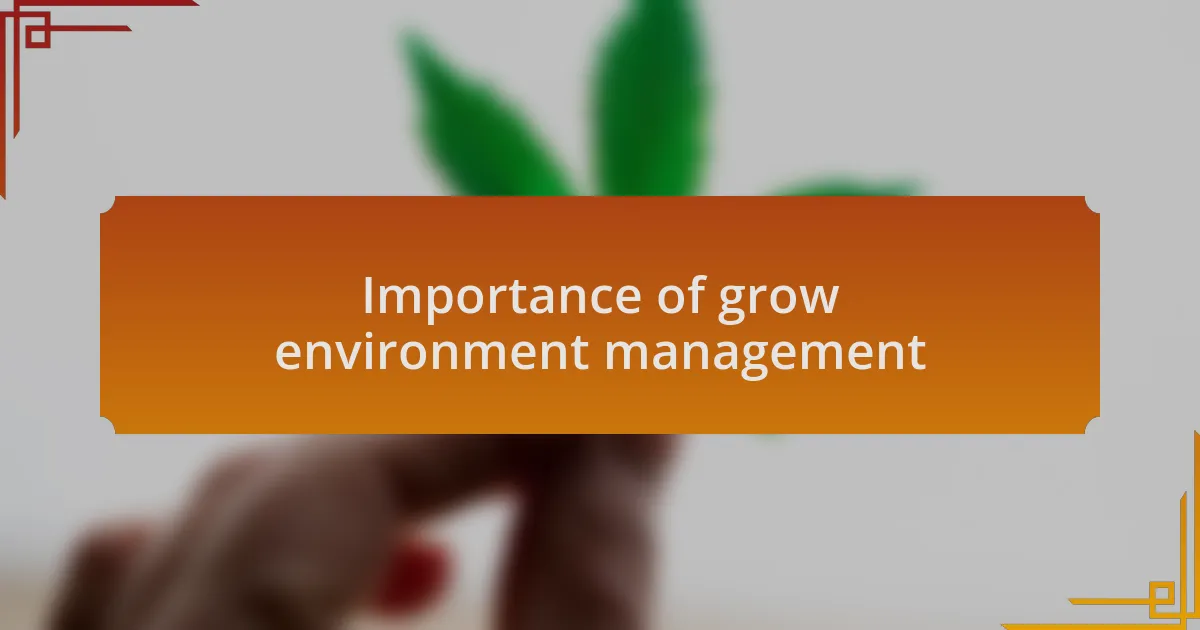
Importance of grow environment management
Managing your grow environment is pivotal for success in cannabis cultivation. I’ve had days where I neglected to monitor humidity levels, only to find my plants wilting by the afternoon. It was a stark reminder of how crucial that control can be, not just for growth but for preventing problems like mold or pests. Have you ever felt that sinking feeling when you realize your plants might be struggling because of environmental factors?
One thing I’ve learned is that consistency is key. I remember the early days of my growing journey when I experimented with temperature; even a slight change could push my plants to flowering or stress them into hermaphroditism. This taught me that every aspect of the grow environment, from the warmth of the lights to the cool drafts, plays a significant role in shaping the health and yield of my crops.
Moreover, creating a well-managed environment cultivates a sense of pride and accomplishment. I once transformed a lackluster batch into a thriving one simply by adjusting the airflow. Witnessing that turnaround was thrilling—it made me realize that I’m not just growing plants; I’m building a thriving ecosystem. What adjustments have you made that resulted in unexpected success?
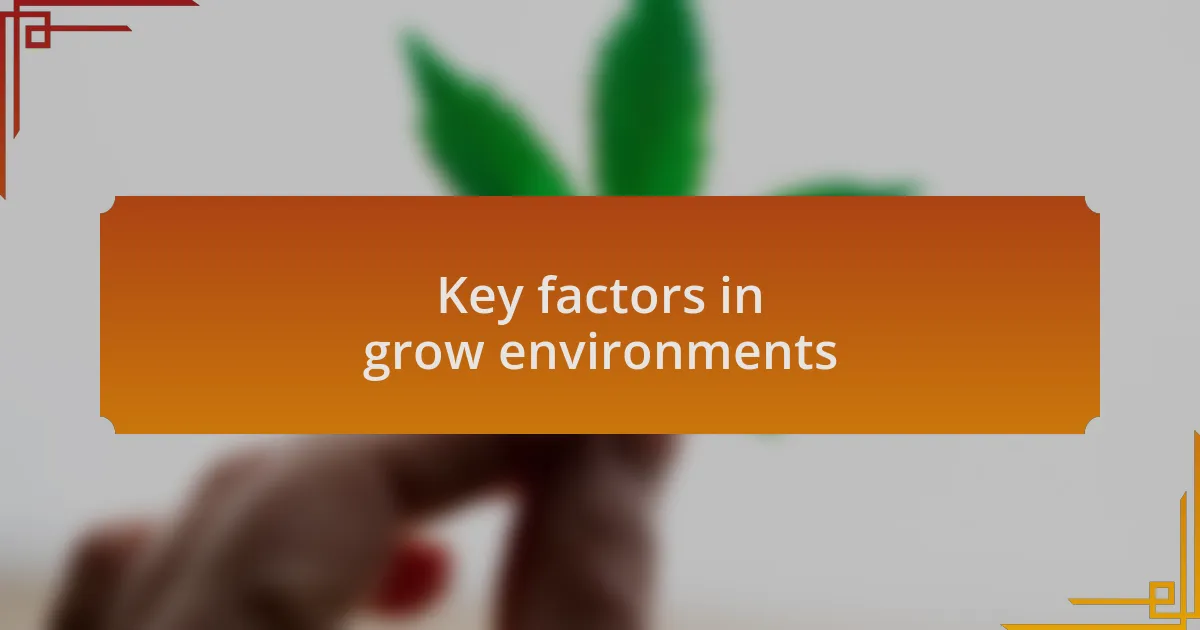
Key factors in grow environments
One fundamental factor in my grow environment is light quality. I recall a time when I was using standard fluorescent bulbs. My plants were growing, but their health suffered. Switching to full-spectrum LED lights not only boosted their growth but also enhanced their potency. Have you thought about the impact of light on your crop’s development?
Humidity levels have often played tricks on me, too. During one grow, I noticed that my plants looked droopy, and the leaves felt soft to the touch. I quickly realized that the humidity was too high, leading to excessive moisture and potential mold issues. Since then, I’ve invested in a good hygrometer, allowing me to better regulate those levels. How do you keep track of your humidity?
Finally, I believe that airflow is an underappreciated aspect of a successful cannabis grow. I vividly remember my first attempt, where I neglected to circulate air properly. The result? Stagnation and pests. Since adding oscillating fans, my plants have flourished, and I feel a sense of relief knowing they’re in a healthier space. Doesn’t the idea of a thriving environment fill you with excitement?
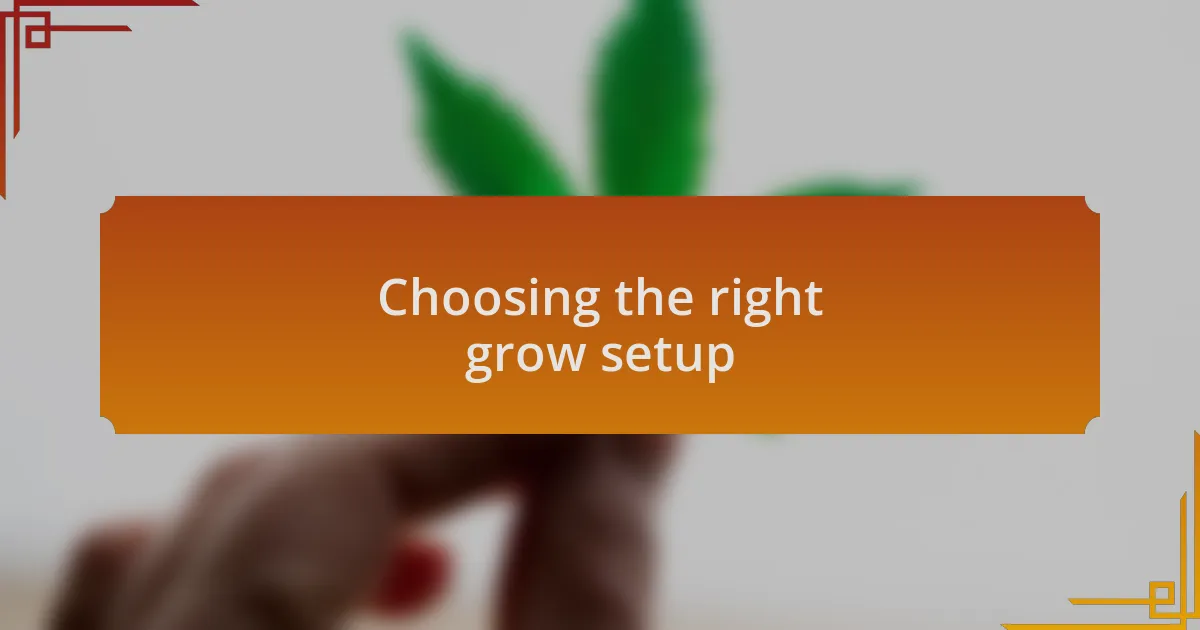
Choosing the right grow setup
Choosing the right grow setup is essential to cultivate healthy cannabis plants. When I was selecting my first grow tent, I remember feeling overwhelmed by the options available. After several hours of research, I settled on a tent with reflective walls to maximize light efficiency. This decision was a game-changer; it allowed me to leverage every bit of those pricey LEDs. Have you found your perfect setup yet?
Temperature control is another vital aspect I initially overlooked. In one of my earlier grows, the temperature spiked unexpectedly, and I was devastated to see my plants stress out and stop growing. Investing in a reliable thermostat transformed my environment into a more stable haven for my plants. How do you ensure that your grow area stays at the optimal temperature?
Lastly, I can’t stress enough the importance of choosing the right medium. During my experimentation, I dabbled with hydroponics, and while it sounded intriguing, I found it challenging to master. Ultimately, I embraced soil and invested in high-quality organic potting mix, which not only simplified my gardening but also enhanced the flavor of my buds. Have you tried different growing mediums to see which works best for you?
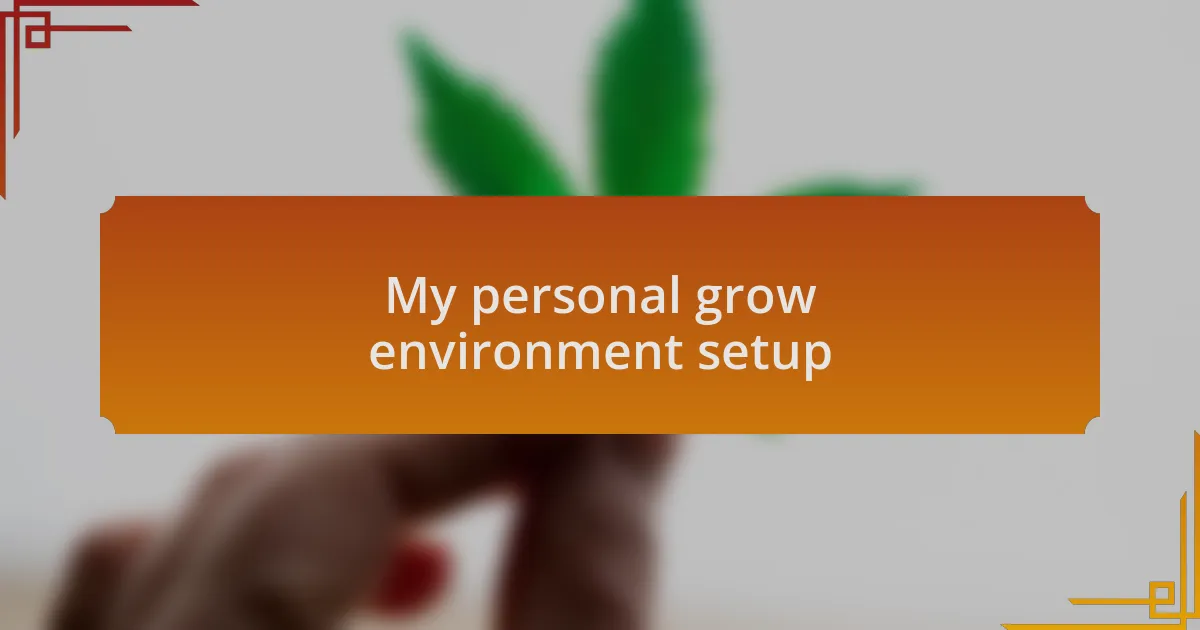
My personal grow environment setup
When it comes to my personal grow environment setup, I can’t stress enough how crucial proper lighting has been. I remember my early days when I relied on cheap grow lights, and the results were pretty disappointing. Once I upgraded to full-spectrum LED lights, the transformation was incredible; my plants escaped their sluggish growth patterns and began thriving like never before. Have you experienced a similar revelation with your lighting choices?
I also pay close attention to humidity levels. In the beginning, I didn’t realize how much humidity could impact growth, but after a bout with mold, I became a firm believer in using a hygrometer. Now, I carefully monitor the levels and have invested in a humidifier, which helps maintain the ideal conditions for both seedlings and flowering plants. How do you go about managing the humidity in your space?
Lastly, I found creating a good airflow system essential for my setup. I made the mistake of assuming still air was fine until my plants started exhibiting signs of stagnation. By adding a couple of oscillating fans, I not only improved air circulation but also strengthened the stalks of my plants. Have you looked into the benefits of airflow for your own setup?
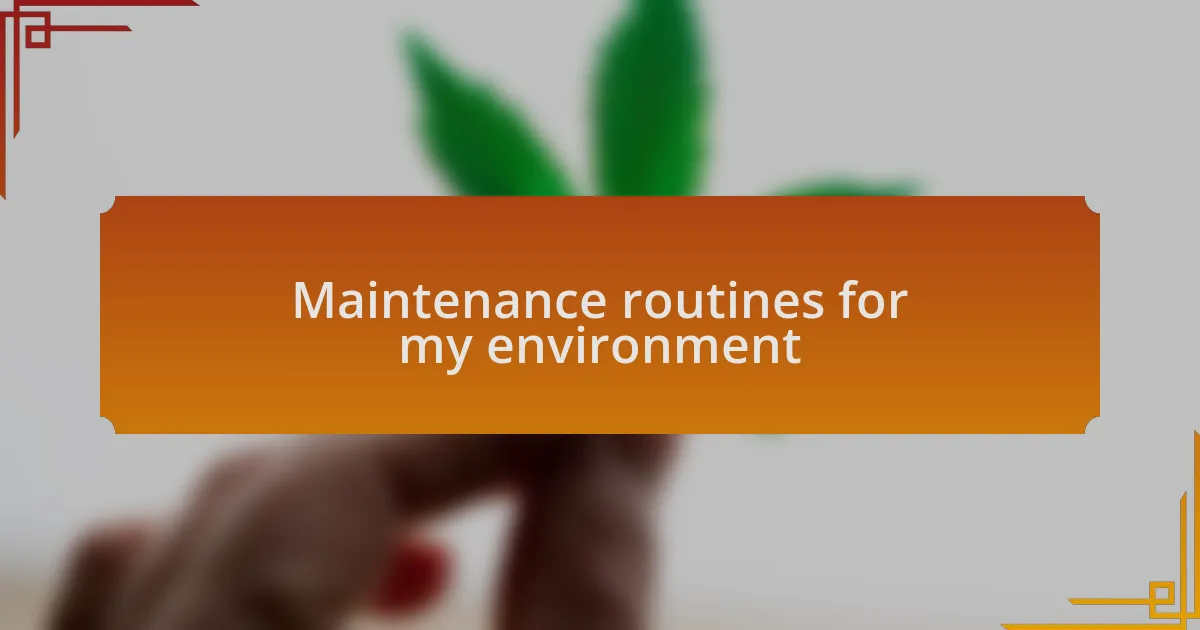
Maintenance routines for my environment
Maintaining my grow environment involves a meticulous routine that ensures everything is in optimal condition. One of the first things I do at the beginning of each week is to inspect the plants for any signs of pests or diseases. I’ve learned that catching an issue early saves a lot of heartache later on. Have you ever had a pest problem spiral out of control?
Watering is another pivotal part of my maintenance routine. Initially, I struggled with overwatering, which caused root rot in a few delicate plants. Now, I test the soil moisture before watering and stick to a consistent schedule. This simple practice has completely transformed my confidence as a grower. Do you think a regular watering schedule could help your plants thrive?
Finally, I dedicate time to cleaning my grow space regularly. I use an all-natural solution to wipe down surfaces and remove any debris. This not only helps prevent mold and mildew but also creates a fresh start for my plants each week. There’s something so satisfying about tending to my space; it feels like I’m nurturing not just the plants, but my entire growing experience. How often do you clean your grow area?
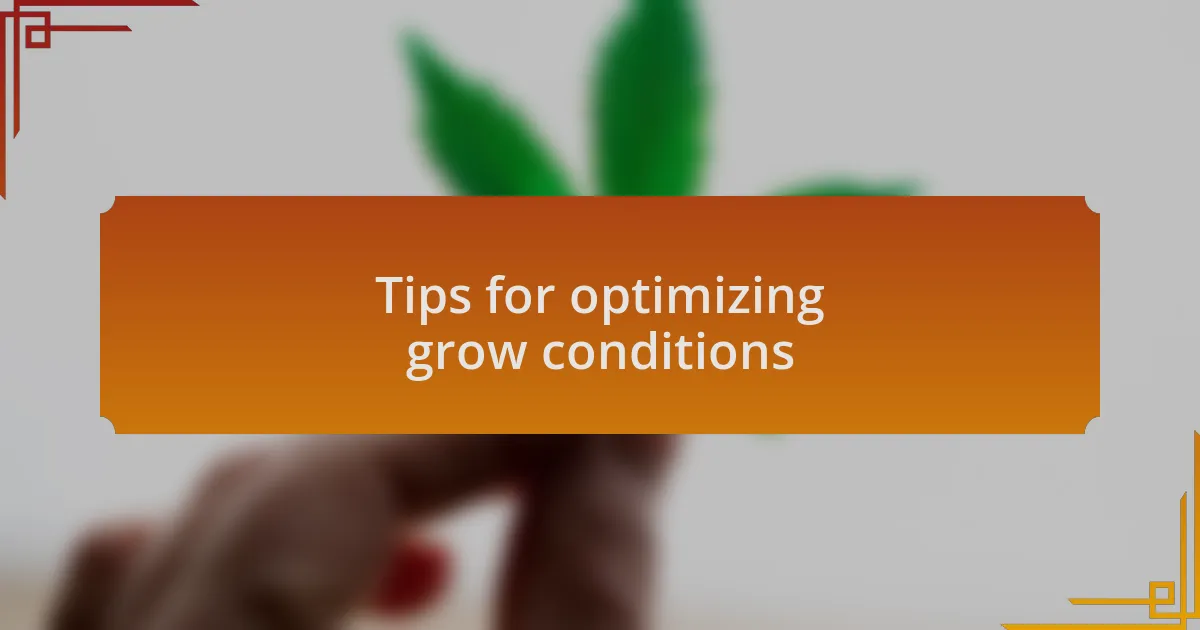
Tips for optimizing grow conditions
When it comes to optimizing grow conditions, I’ve found that maintaining a consistent temperature is crucial. I recall one season where I neglected to monitor my grow room temps closely, and that led to stunted growth. Now, I always aim for a range between 70 and 80 degrees Fahrenheit during the day, with a slight drop at night. How do your plants respond to temperature fluctuations?
Humidity levels also play a significant role in plant health. In my experience, keeping humidity between 40-60% makes a marked difference in how lush and vibrant my plants look. One time, when I let the humidity drop too low, I noticed the leaves beginning to curl. Since then, I’ve incorporated a humidifier to maintain that sweet spot—have you considered how the moisture in the air affects your plants?
Finally, I can’t stress enough the importance of good airflow. I used to underestimate this aspect, thinking it was all about light and nutrients. However, once I installed a simple fan to circulate air, I noticed healthier growth and fewer instances of mold. Can you imagine what better airflow might do for your plants? Ensuring that fresh air circulates helps strengthen stems and reduces the likelihood of pests settling in.